
Cedar Mountain

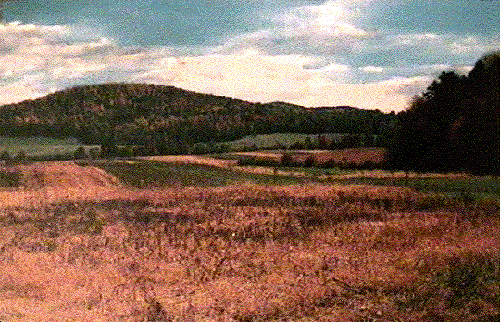
HDQRS. TWENTY-SEVENTH REGT. INDIANA VOLUNTEERS,
August 12, 1862.
SIR: I have the honor of submitting the following report of the part taken in the battle of the 9th instant by the Twenty-seventh Regiment Indiana Volunteers:
My regiment occupied the extreme right of our brigade in the position first occupied. I was ordered by you to throw two companies forward and occupy an advanced position. I immediately sent Companies F and C about three-quarters of a mile to our right and front, occupying a high ridge of ground covered with timber, and deployed a part of each company forward about one-quarter of a mile as skirmishers, holding about half of each company on the highest part of the ridges as reserves. From this position the surrounding country for some distance was in plain view, and from the disposition made of the two companies our right was amply secured from surprise by any flank movement of the enemy on our right. Shortly after this disposition had been made of my two companies the artillery on our front and left commenced firing, which continued until about 6 p.m.
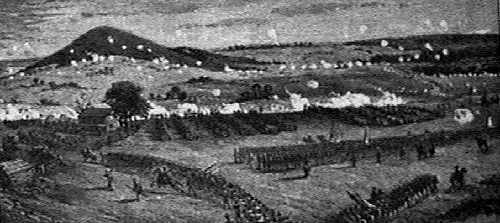
At or about this time I received orders from you through your assistant adjutant-general, Captain Scott, for me to form my regiment and march to the front, which order I complied with as promptly as possible. I marched to the front and near the Sixteenth Indiana Battery and was then halted by your command, as I suppose, for some minutes and until I received orders to march to the front and on the right of the Second Massachusetts Regiment. I immediately marched to the front and right to gain my position in compliance with the above order. As soon as I had gained the desired position I halted the regiment and formed line of battle in an open field about 300 yards in front of the foot of the ridge in our front, which was covered with a thick undergrowth and heavy timber. About the time I commenced forming my regiment into line the Third Wisconsin Regiment, or six companies of it, that had been brought into the action some time previous, fell back out of the woods and came down the hill apparently badly cut to pieces, a part of whom rushed through my ranks and delayed me some in forming my line of battle.
As soon as my line was formed I marched to the front in order to bring my regiment into action. To gain the position of the enemy I had to cross an open space of ground of about three yards, through which meandered a small stream, with very deep and steep banks. In crossing this my ranks became considerably broken. I halted the regiment a moment in order to adjust my ranks. At this time you rode up on my right and ordered me forward at double-quick. The regiment moved forward at double-quick time. I think we had at this time about a quarter of a mile to go until we reached the enemy. The shape of the hill and woods was such that it brought my left wing to the foot of the hill and into the woods at least 100 yards before the right wing reached the woods. The hill on my left was also steep and abrupt. From these causes the left-wing of my regiment was not able to come into action as promptly as the right. The whole regiment having had to pass through the woods and up hill at double-quick, the result was that no part of the line at any time during the action was as perfect as it should have been. When we had traversed the hill and crossed the woods on its summit we suddenly came to a wheat field. We hod scarcely reached the inclosure before the enemy opened a very heavy fire upon us, which was promptly returned by my right wing, the left not having arrived yet upon the line of battle. The enemy appeared to be posted in great numbers in the woods in our front across the field and within rifle-range. They also had skirmishers thrown forward and screened behind the stacks of wheat in the field on my right and nearly at a right angle with my line. The enemy had a regiment drawn up in line of battle, the line extending nearly across the field and facing toward my left. This regiment also opened a cross-fire upon me.
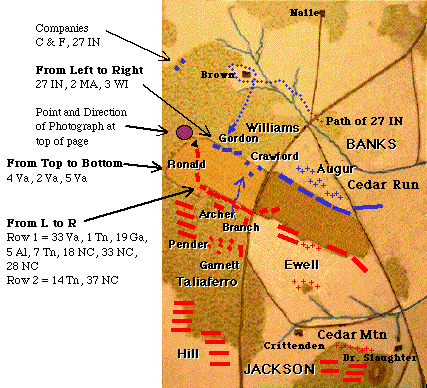
Shortly after the left wing came up and engaged the enemy it was reported to me that we were firing upon our own troops. I saw you at the right of my regiment and rode forward and informed you of my information. You replied that you would ride forward and see. By this time a large portion of my regiment, in consequence of said report, had almost ceased firing. I saw you on the right of my regiment ride forward to the fence and immediately a very heavy fire was opened upon that part of the line by the enemy upon you. I cannot conceive how you possibly escaped it without injury. From this moment the firing of the enemy became heavier along the whole line, I suppose induced by the temporary slacking of the firing in my lines. The firing of the enemy seemed to me to increase. I soon saw symptoms of disorder in my ranks, and in spite of all I could do the regiment fell back, and was not rallied until it reached the open ground on the other side of the woods, a distance of 150 to 200 yards. In rallying and reforming the regiment at this point, and indeed during the whole action, I was aided by yourself and your staff, and particularly Captain Scott, your assistant adjutant-general, whose energy and bravery it is impossible to commend too highly.
My regiment being reformed, we advanced across the hill the second time, and when again near the line of the first battle I halted my men in order to correct and close up my lines and rest them a moment, after which we marched to the front and opened fire upon the enemy. We had fired but one or two rounds when I was informed that the enemy had gained our rear on the right flank. I immediately rode to the right of my line, and by the time I got there I found a regiment of the enemy marching in column by companies a little in front of my line and within 20 steps of my right. I immediately gave the order to my right to change front by the right flank and by file right, which order was obeyed by Company A only. The enemy opened a very heavy fire upon us. My regiment was soon compelled to fall back a second time, and was not rallied until we had retreated to the creek in the bottom. At this point again you in person (and I noticed Captain Wilkins, assistant adjutant-general, of General Williams' staff, and Captain Scott) assisted me in rallying the regiment. From this point I was ordered by you to fall back on my original position.
There are many cases of individual bravery, and especially among my non-commissioned officers, that I might mention. The whole conduct of my regiment and officers transpired under your own personal observation, so far as it was possible for one man to observe. I therefore forbear making any special mention of it.
Inclosed is a list of casualties of the regiment during the action (see below).
Your obedient servant,
S. COLGROVE,
Colonel Twenty-seventh Regiment Indiana Volunteers.
General GEORGE H. GORDON,
Comdg. Third Brigade, Second Corps, Army of Virginia.
The Battle of Cedar Mountain was bloody for the 27th Indiana. The day was excessively hot for the Hoosiers, estimated at near 100 degrees. The terrain was rough. Some soldiers were injured by the ditches, ravines and steep banks of Cedar Run. By the time the 27th was committed to action, the situation for Banks was desperate. He had handled his troops fairly well during the opening moves. He surprised Confederate General Thomas J. 'Stonewall' Jackson. Union Brigadier General Samuel W. Crawford's brigade inflicted a terrible punishment on Garnett's brigade and a portion of Ronald's brigade of Virginians. It was the only time the famous 'Stonewall' brigade was routed during the war. There is no doubt this happened though it receives little attention by historians. Read this excerpt of Confederate Brigadier General L. O'B. Branch's report of the battle:
Journal entry for August 13th. "General Jackson came to me and told me his left was beaten and broken, and the enemy was turning him and he wished me to advance. I was already in line of battle and instantly gave the order, 'Forward March.' I had not gone 100 yards through the woods before we met the celebrated Stonewall Brigade, utterly routed and fleeing as fast as they could run" (From Battles and Leaders, Vol II, page 459).
Crawford's men hit them hard, charging across the wheat field and into the woods. The rebels broke and ran under the onslaught. It was short lived. Archer, Branch and Pender quickly responded with their Confederate brigades. Crawford's men could not hold and suffered terribly as they fell back across the wheat field. Banks had no reserve. He was outnumbered 22,000 rebels to his 12,000 Federals and he needed to use the remaining brigade to protect his right flank.
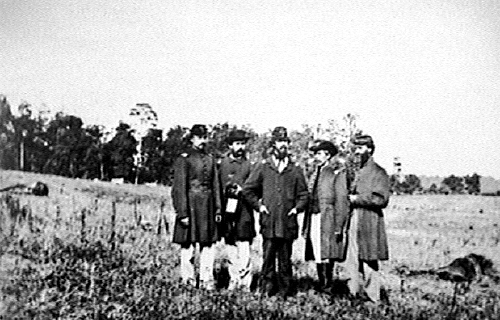
The remaining brigade was Gordon's. Gordon had selected a good position back of the woods north of the wheat field and was sure he could destroy anything that rose out of the creek. He, too, was uncomfortable with the right and instructed Colonel Colgrove to send some troops over in that direction. Colgrove dispatched Companies C & F to the next clearing and Gordon sent his personal cavalry escort to the same location. As Gordon braced himself for action, Williams ordered him to advance immediately to the front and support Crawford. While understandable, it was not the best order in hindsight. Gordon would now have to leave his protected position and cross the same woods and creek that he expected would break up the rebels as they attempted to cross it. Now it would be his brigade that would struggle through the vines and creek banks. Even worse, he did not know who was on the other side nor if Crawford's men were still there.
As you can see from Colgrove's report, the situation was confused once they hit the woods. Men tried to keep order but the terrain made it difficult. Men slid, fell, and cursed. When they climbed the 45 degree embankment to get across the run, they found themselves already in contact with the rebels. Combat was hand to hand with these skirmishers or advance elements from Ronald's Confederate brigade. Once near the clearing, the fire was galling. The Hoosiers wavered and had to be reformed. They came back for more and poured some effective fire at the rebels across the wheat field. Now they were nearly flanked by Ronald's troops on their right. Company I was especially hit hard as was A Company.
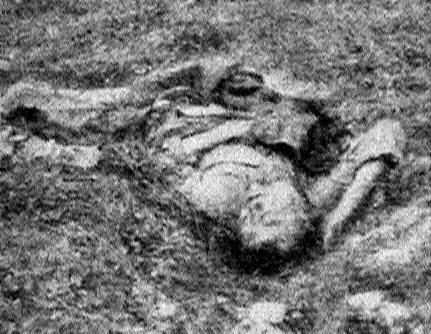
The regiment had suffered badly. So did the 2d Massachusetts and what was left of the 3d Wisconsin. Gordon was doing all he could to hold off two confederate divisions. Williams gave him the order to fall back to the next wood line. The order could not have come a moment too soon. Confederate general A.P. Hill was now maneuvering his division around the union right. If they stayed they would have been annihilated. The brigade left many dead and wounded on the field. Some of the dead would be recovered in a truce a couple of days later. Companies C & F were isolated and did not know that they were actually being enveloped. As night fell, they skillfully worked their way back skirting the wood line and found their regiment after some harassing by Sigel's provost guards.
The battle ended with Augur's and Williams' divisions falling back into Pope's army. The tragedy was that an entire Union corps, the I Corps, was within supporting distance of Bank's beleaguered forces. Banks had fought well and hard. Had he the proper support, the initial success and shock of the attack could have spelled trouble for Jackson. As it stood, numbers, not skill, won the rebel victory this day. Jackson claimed it as his finest battle in his reports but this can hardly be the case. He was surprised by the assault. He misread the ground on his left, which caused him to have an open flank, resulting in the complete route of his old brigade. He recovered well, though, and soon took command of the situation with clarity and skill. Had the Union been supported in force, the rebel lines would have at best been forced on the defensive and perhaps would have crumbled.
For the Hoosiers it was another defeat. They fought bravely. Unlike Winchester, they got better than they gave due to the terrain and instant contact with the rebels in the wood line. Still, they reformed every time and fell back in an orderly retreat. They did not rout. By nightfall they would have their regiment able to fight again if needed. Instead, Banks troops were given a break due to their battle this day and were on baggage detail during the upcoming Second Battle of Bull Run. Banks was given an even longer rest. Transferred to the defense of Washington, he would eventually lose his command and be sent to the West where he would have additional misfortune in New Orleans and along the Red River. His divisions were taken to form a new corps--the Twelfth. The regiment underwent several officer and noncommissioned officer changes during this time to replace the combat loss. With the prisoners not yet exchanged from Winchester and Buckton, and with another 50 men gone, the regiment would have a little over 400 men ready for their greatest challenge of all in a cornfield near Antietam Creek and Sharpsburg, Maryland.
�
Steve Russell
1 Officer and 19 enlisted men actually Killed (vice 1 & 18 reported)
|
Company A |
Company I |
|
First Sergeant William Allen |
First Lieutenant George W. Reed |
|
Sergeant Noah Allee |
Private Thomas Devereaux |
|
Private Richard A. Proctor |
Private Charles Lewis |
|
Company B |
Private Henry Lewis |
|
Private William R. Carson |
Private George D. Martin |
|
Company D |
Private John W. Martin |
|
Private Bloomfield Beavers |
Private Abraham Schwartz |
|
Private John H. Culbertson |
Private David Tuggall |
|
Company E |
Company K |
|
Sergeant Thomas Hill |
Private Bernard Hock |
|
Corporal John M. Jones |
Private George Yochrin |
|
Private John B. Jones |
|
|
Private Philip Ross |
|
2 Officers and 25 enlisted men actually Wounded (vice 1 & 28 reported)
|
Company A |
Company G |
|
Corporal Emanuel Nicewander |
Sergeant Charles A. Kelso |
|
Private William Dodson |
Private Joseph Stimson |
|
Private Simpson Evans |
Company H |
|
Private Charles W. Gibbons |
Private Philip Cox |
|
Private Evan T. Grider |
Private Francis Dooley |
|
Private Charles Wishmeyer |
Private William Francis |
|
Company B |
Private Nicholas Warner |
|
Private George M. Critchlow |
Company I |
|
Company C |
Captain Tighlman H. Nance |
|
Private Emanuel Fulp |
Company K |
|
Company D |
Sergeant John B. Melchoir |
|
Sergeant Silas Whitler |
Corporal Conrad Eckert |
|
Corporal Austin N. Wilder |
Private Celestine Eckert |
|
Private Elijah I. Crawford |
Private Bernard Knust |
|
Private Clemmons Johnson |
Private Jouhn Meister |
|
Company E |
|
|
Captain George W. Burge |
|
|
Corporal Abner McDonald |
|
|
Private Seth White |
|
1 Officer and 5 enlisted men Missing
|
Company A |
|
Private Earl Moore, wounded, captured & exchanged |
|
Company D |
|
First Lieutenant Thomas J. Box, wounded, captured & exchanged |
|
Company H |
|
Corporal Newton H. Fitzgerald, wounded, captured, died |
|
3 remaining others are unknown |
TOTAL CASUALTIES = 54
For comments or suggestions, please contact Steve Russell
�